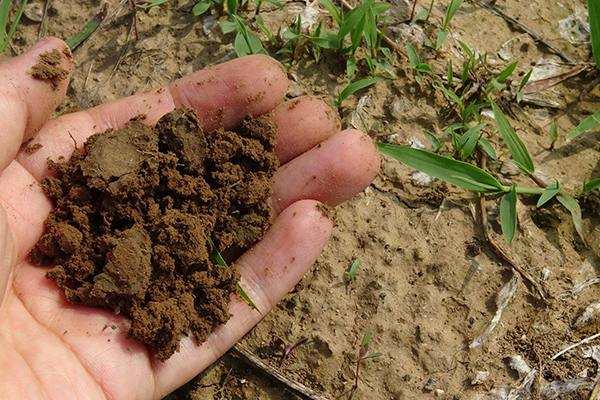
by Andrew Pasquale Thursday, February 16, 2017

Accounting for soils in greenhouse gas-related policies could benefit both emissions reduction and sequestration efforts, researchers say. Credit: Jing, CC0 Public Domain
As scientists continue studying the web of natural and anthropogenic processes that affect Earth’s climate, discussions about how to limit global warming have included proposals both to cut emissions and to increase sequestration of greenhouse gases through a variety of methods.
In a recent review published in Nature, Keith Paustian, a soil ecologist at Colorado State University, and his colleagues noted the understudied and underrated greenhouse gas mitigation potential of the world’s soils. Accounting for soils in greenhouse gas-related policies, they suggested, could benefit both emissions reduction and sequestration efforts, and requires no new technological developments.
Paustian and his colleagues wrote that soil-based greenhouse gas mitigation strategies must consider both land use and land-use change. Agriculture accounts for 10 to 14 percent of total global anthropogenic greenhouse gas emissions and land-use changes like deforestation account for 12 to 17 percent of emissions.
These numbers tell us two things, according to the researchers. First, there’s room for farmers and landowners to employ practices that reduce greenhouse gas emissions and increase sequestration, such as adding compost or biochar to increase soil carbon content, or applying nitrogen fertilizers in lower quantities only where and when crops need it; and second, relatively undisturbed ecosystems like forests, grasslands or wetlands should, ideally, be conserved or restored from agricultural use.
Carbon and nitrogen move through ecosystems via individual chemical cycles, but these cycles are tightly linked, meaning ecological variables like soil temperature and soil water content as well as agricultural practices like tilling and fertilization can affect both. Thus, land managers can get the biggest bang for their buck if they consider solutions that address both carbon and nitrogen simultaneously, the authors suggested.
Resource-saving soil management practices are important not only “for more sustainable agriculture, but they also go hand in hand with reducing greenhouse gas emissions,” Paustian says.
He says that more traditional sequestration solutions, such as afforestation (replacing forests where they have been previously cut down) and engineered carbon capture and sequestration systems remain viable mitigation options, but that ignoring the role soils could play is not in our best interest. Soils “are not the only [option], but they look more important now [as carbon sinks] than we previously thought.” Due to the sheer volume of soil on Earth, the potential for reductions in soil emissions and increases in sequestration really add up, he says.
The biggest barriers to implementing soil-based strategies, Paustian and his colleagues concluded, have to do with effectively using existing technologies and making accurate quantification of emissions, and emission reductions, more cost-effective.
The challenge for economists and policy makers is to convince people of the importance of engaging in such efforts, Paustian’s team wrote. The researchers outlined several policy mechanisms that could contribute to soil-related greenhouse gas reductions — direct taxes, for example, in which emitters pay a set price for their emissions, and subsidies incentivizing producers to cut emissions. Perhaps most important, at least in the U.S., Paustian says, are supply-chain initiatives in which food distributors set emissions standards for farmers from whom they purchase, and cap-and-trade emissions markets.
“In principle, carbon prices in a market would reflect the social cost of emissions,” says Valentin Bellassen, an expert in carbon economics at France’s Center for Economics and Sociology Applied to Agriculture and Rural Spaces, who wasn’t involved with the new paper. “In practice, the largest carbon pricing mechanisms are markets that emerge from a cap put by the regulator on total emissions [permitted],” he says, and the prices actually “emerge from the confrontation of supply and demand.”
Currently, there are two types of markets for emissions: compliance and voluntary. Some emitters, like power plants, are legally required to reduce their greenhouse gas emissions below specific thresholds, and so operate in a “compliance market.” If emitters in compliance markets are unable or unwilling to reduce their own emissions, they can purchase the right to emit a certain amount of greenhouse gases at a specified price per mass of emission as an “offset” from another business. In turn, that other business must have either reduced its own emissions or bought the offset from another company that has. In a voluntary market, emitters that are not required to reduce their greenhouse gas emissions can still do so — and then sell those offsets to others — as long as they can reliably document their emissions and emission reductions.
Right now, agricultural producers in the U.S. are not required to reduce greenhouse gas emissions. “For the foreseeable future, it’s hard to see agriculture or land-use activities being regulated that much, at least from the standpoint of greenhouse gases,” Paustian says. “The industry is not forced to reduce emissions, so it has to participate — if it’s going to participate — as an offset [in the voluntary market].” He notes that part of the reason why agriculture is not regulated could be because there are so many small and diffuse sources of greenhouse gases on farms. In other words, there is no smokestack that someone can put a meter on and be sure they are capturing every source of emissions.
© 2008-2021. All rights reserved. Any copying, redistribution or retransmission of any of the contents of this service without the expressed written permission of the American Geosciences Institute is expressly prohibited. Click here for all copyright requests.